Bond paper offers a smooth surface ideal for professional printing and writing, while Kraft paper provides superior durability and tear resistance for sturdy envelope construction. Both materials vary in weight and texture, with bond paper typically lighter and kraft paper featuring a natural, coarse finish.
Table of Comparison
| Feature | Bond Paper | Kraft Paper |
|---|---|---|
| Material | Bleached wood pulp | Unbleached wood pulp |
| Texture | Smooth, fine-textured | Rough, coarse-textured |
| Strength | Moderate tensile strength | High tear and tensile strength |
| Color | White or off-white | Natural brown |
| Weight | Typically 16-24 lbs | Typically 40-80 lbs |
| Usage | Letterheads, standard envelopes | Heavy-duty envelopes, packaging |
| Cost | Lower to moderate cost | Moderate to higher cost |
| Environmental Impact | Usually bleached, less eco-friendly | Unbleached, biodegradable, eco-friendly |
Introduction: Bond Paper vs Kraft Paper for Envelopes
Bond paper offers a smooth, high-quality finish ideal for professional and formal envelope applications, ensuring crisp printing and durability. Kraft paper provides a sturdy, eco-friendly option with a natural brown texture, commonly used for rustic or industrial-style envelopes requiring strength and recyclability. Choosing between bond and kraft paper depends on the desired aesthetic, durability, and environmental considerations for envelope use.
What is Bond Paper?
Bond paper is a high-quality, durable writing paper commonly used for official documents and stationery such as envelopes. It is characterized by its smooth texture, brightness, and strength, making it ideal for printing clear text and sharp images. Unlike Kraft paper, which is coarse and brown, bond paper offers a professional appearance and better compatibility with printers and copiers.
What is Kraft Paper?
Kraft paper is a durable, unbleached paper made from wood pulp using the kraft process, known for its high tensile strength and resistance to tearing, making it ideal for packaging and envelopes. Compared to bond paper, which is smoother, white, and typically used for writing or printing, kraft paper offers a rustic, natural appearance suited for eco-friendly or heavy-duty envelopes. Its thickness and toughness provide enhanced protection for mailed contents, especially in craft or industrial applications.
Key Differences Between Bond Paper and Kraft Paper
Bond paper is a smooth, high-quality paper typically used for formal documents and envelopes requiring a professional appearance, while Kraft paper is a sturdy, coarse, brown paper commonly utilized for durable, eco-friendly packaging envelopes. Bond paper offers better print clarity and a cleaner finish, whereas Kraft paper excels in strength, tear resistance, and environmental sustainability. The choice between the two depends on the need for aesthetics and print quality versus durability and recyclability in envelope applications.
Durability and Strength Comparison
Bond paper, known for its smooth texture and high-quality finish, offers moderate durability suited for everyday envelopes but may tear under heavy stress. Kraft paper, made from sturdy wood pulp fibers, provides exceptional strength and tear resistance, making it ideal for envelopes requiring enhanced protection and durability. In applications demanding robustness and the ability to withstand rough handling, kraft paper envelopes outperform bond paper in terms of longevity and structural integrity.
Aesthetic Appeal and Presentation
Bond paper offers a smooth, clean surface ideal for professional and formal envelopes, enhancing presentation with its crisp white or subtle off-white tones that highlight printed text and logos effectively. Kraft paper provides a rustic, natural aesthetic with its coarse texture and earthy brown hues, appealing to eco-conscious brands seeking a handcrafted or vintage look. Choice between bond and kraft paper envelopes depends on desired visual impact, where bond aligns with polished sophistication and kraft emphasizes organic charm.
Printability and Customization Options
Bond paper offers superior printability with smooth surfaces that allow for crisp, high-resolution text and images, making it ideal for detailed logos and vibrant colors on envelopes. Kraft paper, while less smooth, provides a natural, rustic texture that can be effectively customized using stamps, embossing, or minimalistic printing methods suited for eco-friendly or vintage-style branding. Customization on bond paper supports a wider range of printing techniques including offset, digital, and laser, whereas kraft paper customization often relies on screen printing or letterpress to maintain print clarity on its coarse surface.
Environmental Impact of Bond and Kraft Paper
Kraft paper envelopes are more environmentally friendly due to their high recyclability and biodegradability, made from unbleached pulp requiring less chemical processing, reducing pollution and energy consumption. Bond paper envelopes, often bleached and chemically treated for smoothness and whiteness, involve higher environmental costs including increased water usage and chemical discharge during production. Choosing kraft paper envelopes supports sustainable practices by minimizing carbon footprint and promoting the use of natural, renewable resources.
Cost Considerations
Bond paper envelopes generally cost more due to their smoother texture and higher-quality cotton or wood pulp content, making them suitable for professional correspondence. Kraft paper envelopes are more budget-friendly, made from recycled materials or unbleached pulp, offering durability at a lower price point. Businesses often choose Kraft paper envelopes for bulk mailing to optimize cost efficiency without sacrificing strength.
Choosing the Right Paper for Your Envelope Needs
Choosing the right paper for your envelope depends on durability, texture, and appearance requirements. Bond paper offers a smooth, professional finish ideal for formal correspondence and printing, while kraft paper provides a sturdy, rustic look perfect for packaging and eco-friendly branding. Consider the envelope's purpose and desired impression to select between bond paper's refined quality and kraft paper's rugged strength.

Infographic: Bond paper vs Kraft paper for Envelope
 azmater.com
azmater.com